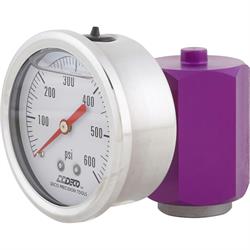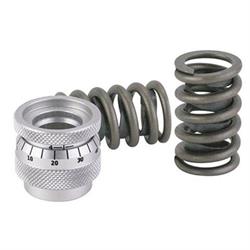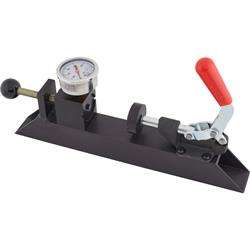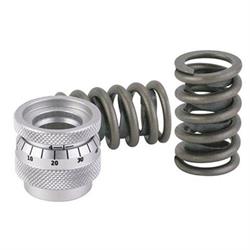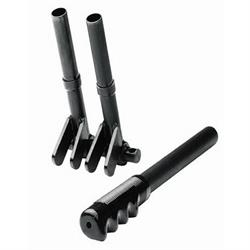How to Match Valve Springs to Cam | Single Valve Spring vs Dual
What Valve Springs Do I Need?
The valve spring is a critical part of your engine’s valvetrain and should not be considered lightly. This isn’t a part that you can simply buy without intimate knowledge of your engine’s valvetrain specifications. Camshaft lift and duration, valve stem height, spring seat depth and more all play integral parts in the proper valve spring selection. Furthermore, your driving style or application (street use or high-rpm racing use for example), are key factors as well. Using the correct valve springs ensures optimum performance and engine longevity. Besides the technical aspects of valve springs (installed height, spring pressures, etc.) there is the aspect of spring type, which is your first decision to be made in your eventual spring choice. From the classic single spring (with or without a damper), to double springs, and even the more modern beehive valve spring and conical spring choices, it is important to understand what each spring type can support to learn how to match valve springs to cam choice.
Single Valve Springs
- Best for stock or mild performance applications.
- Simple and cost-effective, offering sufficient support for lower rpm use and mild cam profiles.
Dual Valve Springs
- Best for high-performance and racing applications.
- Dual springs provide extra strength and control, making them ideal for high-lift camshafts and high-rpm engines, where valve float is a concern.
Beehive Valve Springs
- Best for performance applications requiring lightweight and high-rpm stability.
- Their unique shape reduces mass at the top, allowing for better control and higher RPM potential without needing dual springs.
Conical Valve Springs
- Best for modern engines and applications demanding efficiency and reduced stress.
- These springs taper toward the top, spreading stress more evenly and reducing harmonic vibrations for better reliability at high rpm.
How to Match Valve Springs to Cam
Generally, your camshaft will come with a cam card stating the camshaft’s specifications, including recommended spring rates. The manufacturer isn’t always going to state spring type, but the minimum rates to work with the camshaft’s lift and duration. This is important because there are often differences within engine families from the same manufacturer. For example, you’ll find differences between SBC valve springs and BBC valve springs. There is still going to be some research required on your end to ensure the springs you choose are appropriate for your cylinder head as assembled on your engine. This includes any machine work (have the heads been surfaced/decked?) and even head gasket thickness. For those new to building engines and working with valvetrain, let’s go over some of the terms we’re using in this piece and their definitions to help you with how to match valve springs to cam needs. You can also learn more about camshaft specifications explained in our related Toolbox content, including learning what types of camshaft are best for your needs.
Camshaft Lift: Lift is how far the valve opens into the combustion chamber, measured in thousandths of an inch. A higher lift camshaft allows more air and fuel to enter the combustion chamber but also means the springs must compress further. You’ll need the proper valve sprint to prevent coil bind.
Camshaft Duration: As its name implies, this is the duration, or how long the valve stays open during the camshaft timing event cycle. The longer the duration, the longer the valve spring is compressed, increasing stress on the spring. A higher rate spring is used to compensate for longer duration camshafts to prevent valve float.
Valve Float: A condition where the valves do not close properly, losing control due to high engine speeds and weak or wrong valve springs, preventing the valves from following the camshaft profile. This causes a loss of power and can be potentially damaging to the engine.
Coil Bind: An issue where the valve spring is too stiff, spring seat is too shallow, or the valve spring is compressed too far (rocker ratio, etc.) and the valve spring coils compress to the point where the coils touch each other, preventing further valve from opening any further. Coil bind can damage valvetrain components including the camshaft, lifter, retainer, and more.
Valve Spring Suggestions by Camshaft Type
- Stock or Mild Cams: Use single springs with moderate stiffness.
- Performance Cams: Use dual springs or high-rate single springs for extra control.
- High-Lift Cams: Make sure the spring’s max lift rating is higher than the cam’s full lift at the valve (includes rocker arm ratio) by at least .060-inch.
- High RPM Engines: Choose springs with enough stiffness to handle the engine speed without losing control.
What Does the Valve Spring Do?
The valve spring function in the valvetrain is an important aspect of the whole valve movement from opening to closing, hundreds of times a minute (and that’s just at idle speeds!). The valve spring has the tough job of controlling the intake and exhaust valve’s movement. As the camshaft lobe pushes up on the lifter and pushrod, raising the rocker arm end, the opposite side of the rocker arm’s fulcrum point pushes the valve tip down, unseating the valve face from the cylinder head’s valve seats and opening the valve to allow air and fuel in (intake valve) or exhaust gas out (exhaust valve). As this is happening the valve spring is being compressed, loading the spring with energy. As the cam lobe continues rotating the base of the cam lobe comes around, lowering the lifter and pushrod. The valve spring’s stored energy now comes into play as the coiled spring expands, pulling the valve closed and sealing the valve face on the seat, closing off the combustion chamber. When the valve spring choice is correct, the valve springs help to maintain the camshaft’s timing events with full contact from valve tip to cam lobe. Additionally, a carefully chosen spring rate will include keeping valve float at bay, which as we stated previously, can cause a loss of performance or engine damage. These general steps are the same, be it a mechanical camshaft or hydraulic camshaft.
We’ve mentioned spring rate a few times already, so let’s dive into this topic a bit more to better understand how valve springs are chosen to do their job based on said spring rate (among other specs including diameter, spring shape, pressure, and more). A valve spring’s measured spring rate is a value that states how much force is required to compress the valve spring a specific distance. A valve spring rate tester is a great way to confirm a spring’s rate is still within spec. A low spring rate is fine for a low-lift street camshaft but will not be optimal for higher rpm use or high-lift camshafts, where a lower spring rate will induce valve float and the associated potential engine damage. Conversely, high rate springs are better suited for cams with a lot of lift or in high rpm use. But you can go too stiff on your spring rate, which causes undue pressure on your cam lobes, lifters, and other components which will accelerate their wear or potentially cause breakage of these components due to high stress levels. This is why learning how to match valve springs to cam specs is so critical.
Types Of Valve Springs | Which Type Do I Need?
Now that we’ve provided some education and background information on valve springs and what they do, let’s revisit the types of valve springs available today that were mentioned earlier and why you would need to upgrade. Obviously, the primary need for upgrading valve springs is due to new valvetrain components. From the camshaft itself, to running larger valves in your cylinder heads, upgrading the valvetrain will most certainly require updated valve springs to match your new specs. Of course, just replacing tired or stock/original springs with performance valve springs has a lot of merit as well. Stock springs may have many, many cycles on them and cannot support the cam lift specs any longer. Often you will find more usable rpm with a set of performance valve springs replacing your tired stock springs and nothing else. This is a relatively inexpensive way to increase your engine’s rpm operating window without getting deeper into the engine with a cam swap, even on something like a Chevy 454 cam.
- Single springs are best for stock or mild performance engines. They are simple, cost-effective, and ideal for moderate RPM ranges and low-lift cams.
- Dual springs are best for high-lift cams, high rpm use, and race setups. Their added strength and control help to prevent valve float and handle aggressive cam profiles.
- The beehive valve spring is best for lightweight, high-performance applications, as their tapered design reduces weight at the top, improving stability and increasing rpm potential.
- Conical springs are best for modern engines and high-rpm setups. Their tapered coils spread stress evenly, reduce harmonic vibrations, and improve durability.
How Do I Know Which Type of Valve Spring Do I Need?
Proper valve spring selection will certainly come with experience of how to match valve springs to cam choice. We’re not all professional engine builders, but you can make an educated decision by considering several factors and being honest with yourself and your build direction. For example, there’s no need for high rate double springs if you’re doing a restoration-type camshaft (something stock or just barely above stock). Assessing your engine build or upgrade and knowing what your engine’s goals will be for performance or street use, rpm demand, and so forth will all help narrow your focus to the proper spring rate and spring type. Obviously, the critical piece of information here is going to be your cam and lifter kits specs. Many manufacturers will plainly spell out on the cam card what springs are required and the rate of said springs. Even better, they’ll provide a part number for springs that work with your camshaft (buying matching valvetrain components is one way to avoid headaches). Of course, these recommendations can change the more you modify the engine’s overall performance level, but the cam card is a great place to start. Finally, if you’ve worked with a machine shop for some machining or partial assembly of your engine or cylinder heads, reach out to them for recommendations as well, such as beehive valve springs vs dual valve springs for your application, as they have lots of experience in determining how to match valve springs to cam lift and duration.
Beehive Vs Conical Valve Springs | Which Is Better?
The traditional valve spring features a consistent outside diameter from end to end. They have functioned well for over 100 years of service across all forms of internal combustion engine design and can be found in many famous muscle car small block and big block engines. The new kids on the block, so to speak, are the beehive and conical shaped valve springs. The beehive valve spring, while used extensively in piston based aircraft from the earliest days of flying, didn’t see automotive use until the late 1990s in such engines as the Ford Modular family, GM’s LS engine, and more. The LS valve springs are probably the most common beehive application. Conical valve springs on the other hand, while sporadically theorized throughout the 20th century as a possible “better mousetrap,” it wasn’t until more accurate manufacturing and materials became available that a conical valve spring was viable. They were brought to market in the second decade of the 21st century for aftermarket use. So, which one is best for your needs?
Beehive Valve Springs
- Named for their beehive-like shape, these springs have a smaller diameter at the top and a larger diameter at the bottom with the middle section being the widest diameter.
- Their reduced weight decreases the chance of valve float at higher rpm, allowing for better performance in high-revving engines and extending rpm operating range.
- The beehive valve springs advantages include spreading valve spring stress more evenly across the spring body, improving fatigue resistance.
- The beehive design requires the use of smaller (and lighter) retainers, which further reduces weight of the valve spring/valve/retainer/keeper assembly.
Conical Valve Springs
- These springs have a continuous conical taper from top to bottom, resembling a cone.
- Conical springs offer a progressive dampening rate, which helps reduce oscillations and improves valve control at high rpm.
- The conical spring design helps eliminate harmonic resonance, offering better stability across a broader rpm range.
- Conical springs distribute stress more evenly, like beehive springs, enhancing longevity.
When to Choose Which?
Beehive Springs: Ideal for moderate performance upgrades, offering a good balance of weight reduction and high-RPM stability.
Conical Springs: Best suited for extreme high-performance or racing applications where maximum rpm stability and harmonic control are critical.
Dual Valve Spring Vs Single | Pros and Cons
The standard single valve spring design dates back over a century of use and has been applied to just about every engine design, cylinder count, and displacement ever created (rotary folks can sit this one out). The single spring is cost effective from a mass production standpoint and is more than capable of handling the standard rpm use of a typical passenger car or truck engine that typically sees peak power in the 5,500 rpm range, or less. Some single spring designs incorporate a flat wound damper spring installed inside the coil of the main single spring. This is not a “dual spring” valve spring. The flat wound damper is simply used to help with valve spring harmonics by exerting pressure/friction outward against the valve spring. They also add a small amount of valve spring rate to the valve spring package.
A true dual valve spring is one in which there are two separate valve springs, one inside the other, that usually do not touch but can have minor contact depending on spring diameters and coil wire size. They work in unison to increase valve spring rate for high-lift cams, prevent valve float, and act as a redundant valve spring should the primary spring break, possibly preventing the dropping of a valve and major engine damage. Note we said possibly, as there are a lot of variables involved when a valve spring breaks, primarily the engine operating rpm at failure and how quickly you can get out of the throttle. Additionally, you can find for some applications a double spring with flat wound damper slid between the primary and secondary spring. The flat wound damper spring has the same job here as in a single spring offering. Note these are not technically “triple springs.” There are triple valve springs for extreme applications with three valve springs and no damper that we won’t be getting into here.
Single Valve Spring
Advantages:
- Easier to install and less expensive than dual springs.
- Fewer components so there's less friction and heat generation in the valve train.
- Single springs are lighter overall, which helps reduce valve train mass and improves efficiency.
- Suitable for stock or engines with mild upgrades that don’t see extended rpm use or aggressive cam profiles.
Disadvantages:
- The single spring design is more prone to valve float at higher rpm.
- There is less effective control at handling high lift or aggressive cam profiles.
- If the single spring fails, it could lead to severe engine damage.
Dual Valve Spring
Advantages:
- Provides improved control of the valve at higher rpm, reducing the risk of valve float and ensuring precise valve timing.
- Dual springs can handle more aggressive camshafts with higher lift and faster ramp rates.
- If one spring fails, the remaining spring can provide support to the valve retainer and locks, reducing the risk of catastrophic engine damage from a dropped valve.
- Dual valve springs reduce harmonic vibrations compared to single springs (even with a damper), improving overall stability.
Disadvantages:
- Since there are twice the number of springs, which can contact each other, this can lead to higher friction in the valve train.
- Dual spring installation adds weight to the valve train and requires more precise installation with specific spring retainers.
- The dual valve spring setup is more expensive due to the additional components used and the need for specific supporting parts.
When to Choose Which?
Single Valve Springs:
- Ideal for stock or mildly modified engines with moderate rpm limits.
- Applications where weight reduction and simplicity are more critical than high RPM performance.
Dual Valve Springs:
- High-performance or racing engines with aggressive camshafts.
- Needed in applications where stability and valve train control at high rpm are crucial.
What Causes Valve Spring to Break | Valve Spring Coil Bind Clearance
There are numerous reasons why you may see valvetrain failure occur, specifically a valve spring broken. Valve springs are designed to work in a specific “window” and if you exceed this with incorrect installed valve spring height, the wrong spring rate, improper spring diameter to spring seat/cup specs, and other such issues, coil bind, and a broken valve spring is most certainly a possibility. This is why understanding how to match valve springs to cam specs is critical to ensure that you are not only running the proper spring specs for your camshaft, valve length, and cylinder head design, but that supporting parts, such as valve spring keepers, locks, spring seats, and more are correct and fit and work correctly with each other. This can even go as far as the rocker arms and rocker studs. Everything must work and fit together for the proper valvetrain geometry and for things to work in unison at the intended rpm for fear of hearing that awful broken valve spring sound.
What Causes Valve Spring Failure?
Incorrect Spring Rate
- Springs that are too weak for the camshaft allow valve float at high rpm, causing uncontrolled valve movement and eventual spring fatigue or breakage.
- Springs that are overly stiff place excessive stress on the valvetrain, leading to wear on cam lobes, lifters, and even spring failure.
Coil Bind
- Coil bind happens when the spring compresses fully and the coils touch, preventing further compression of the valve spring. This creates a sudden load spike that can leave you with a valve spring broken or damage the camshaft and rocker arms.
Camshaft Mismatch
- High-lift or long-duration cams require springs rated to handle the increased stress. Using stock or undersized springs in these cases can overload the spring and cause it to break prematurely.
Exceeding RPM Limits
- Running the engine beyond the spring’s operating range can cause valve float or bounce, leading to uncontrolled movement and eventually a broken valve spring.
Poor Installation
- Improper installed valve spring height, incorrect shim use, or springs too large for the spring seat/cup can cause excessive tension or allow coil bind.
What Is Coil Bind Clearance?
- Coil bind clearance is the distance between the fully compressed spring and its maximum compressed height (coil bind height). Proper clearance ensures the spring can compress without the coils contacting.
- Aim for at least 0.050"-0.060" minimum clearance between full lift and coil bind height.
- Insufficient clearance leads to coil bind, while excessive clearance indicates the spring may not be providing enough tension for proper valve control.
How to Prevent Valve Spring Failure
- Match the spring rate, max lift, and rpm rating to your camshaft and engine’s needs.
- Measure clearance during installation to ensure proper operation, verifying there is no coil bind.
- Use springs specifically designed for your cam’s lift and duration, usually found on the cam card or packaged instructions.
- Stay within the rpm range of your engine’s components, specifically your camshaft and other valvetrain pieces.
When To Replace Valve Springs | Signs and Timing
It may be tough to consider this, but valve springs are a wear item. Especially in high rpm racing applications. Sure, your daily driver that barely sees 5,000 rpm shouldn’t need valve springs for 100,000 miles or more, but any performance application valve springs are pretty much a consumable (some racers change valve springs every race season). Over their use, compressing and expanding tens of thousands of times, the spring rate drops due to coil spring tension loss. This loss of spring tension may only affect performance at first but eventually can lead to spring breakage and major engine failure. Like any performance vehicle component, removing and testing the springs to ensure they are still within their performance limits is the best way to ensure your springs can still be up to the task, or confirm it is time to replace them. Many of these bad valve spring symptoms can also be broken valve spring symptoms. The use of standard valve spring compressor tools will usually handle the job well, but some jobs use application specific tools, such as the LS valve spring compressor tool.
Why Do Valve Springs Wear Out?
- Constant compression and release, over thousands of miles, causes fatigue in the spring material.
- High engine temperatures and extended high-RPM operation accelerate wear.
- Even if an engine isn’t heavily used, springs can weaken over time due to the cam lobes/rocker arms compressing some of the springs even with the engine off.
Signs of Worn or Failing Valve Springs | Weak Valve Spring Symptoms
- Weak springs may struggle to close valves fully, reducing cylinder pressure and overall performance, causing a loss in power.
- Inconsistent valve timing caused by weak springs can lead to misfires, especially at high rpm.
- If springs lose tension, the valves may "float" and fail to close properly at high speeds, causing power loss or potential damage.
- Worn springs may cause excessive play in the valvetrain, leading to unusual ticking or tapping noises.
- Weak springs disrupt the air-fuel mixture’s timing, reducing combustion efficiency and fuel mileage.
When Should You Replace Valve Springs?
- If you’re rebuilding the engine or replacing the camshaft, it’s a suitable time to install new springs.
- For stock engines, consider replacing valve springs around 80,000-100,000 miles or sooner if the engine has been pushed hard.
- Any upgrade to a high-lift cam or increased rpm range use will require springs rated for these conditions.
- If you notice any of the signs above, inspect the springs for cracks, uneven wear, or reduced tension and replace them as needed.
Why Timely Replacement Matters
- Delaying replacement can lead to valve float and loss of power at high rpm, damage to camshaft lobes, lifters, and other valvetrain components, and catastrophic engine failure if a spring should break. Don’t ignore these warning sounds or performance issues, as they can be symptoms of broken valve spring conditions. Any valvetrain noise or lack of power should be investigated immediately to prevent further damage.
How to Determine Valve Spring Pressure?
- Using a valve spring tester is required to measure open and seat pressure.
A valve spring tester is a specific measuring tool that is used to determine a valve spring’s open and seat pressures. This tool can be a bench mounted tester with a large base and compression handle, or it can be a smaller tool used within a pair of vice jaws for compression of the valve spring. Testing your valve springs is critical to ensure your spring pressures are not too soft or too stiff for your application, which can cause valve float, power loss, or even engine damage.
How Much Valve Spring Pressure for a Roller Cam?
- Hydraulic roller cams typically need 120-140 lbs. of seat pressure and around 260 lbs. open pressure for a small block (130-160 lbs. seat/280 lbs. open for big blocks), while solid roller cams need 180-250 lbs. of seat pressure.
Valve spring pressures are critical to a properly functioning valvetrain. Too little spring pressure can lead to valve float and valvetrain damage. Roller cams require these heavier spring rates due to the heavier body of the roller lifter assembly and the more aggressive cam lobes found on roller cam profiles. As with any cam upgrade, matched valve springs are crucial to a successful cam swap and the recommended valve springs should be installed (or buy a cam/lifter/spring kit to ensure matching components). If purchasing aftermarket heads that are fully assembled, ensure the included valve springs match the cam you plan to use. Otherwise, it may be better to purchase bare heads to assemble yourself or be prepared to swap out the valve springs on your new heads.
What Happens If Your Valve Springs Are Too Strong?
- Springs that are too stiff can cause excessive camshaft wear, lifter failure, and loss of power.
As mentioned above, having the proper spring pressure is critical to valvetrain longevity and peak performance. When your valve springs are too stiff you risk valve float, which in many cases will lead to piston to valve impact that bends valves and damages the piston face. Broken valve stems, retainers, and locks are common with excessively high spring rates, as these parts are highly stressed. Valvetrain noise is also intensified with high spring pressures as well. However, increased wear and friction on valve seats, lifters, pushrods and more are the most common issues with high spring rates.
What Holds a Valve Spring in Place?
- A valve spring retainer seated on the top of the spring holds the valve spring in place. The retainer is secured by keepers (valve locks) placed around the valve stem.
Valve spring retainers are an important part of your valvetrain needs. Not only must they be sized to match your spring’s diameter, but their material can affect valvetrain efficiency. The locks, or keepers as some refer to them, are available in different degrees. Standard locks are usually 7-degree, while there are 10-degree performance locks and even 8-degree locks that split the difference between the standard and performance keeper angles. The important thing to remember is that whatever keeper or valve lock angle you use must match the angle machined into your retainers to properly hold your valve springs in place.
Do Valve Springs Go Bad from Sitting?
- Valve springs can weaken over time due to metal fatigue, even if the engine isn’t running.
This is why it is important for engines that have sat for many years with the valvetrain properly adjusted to pull the valve springs and check their spring pressures. Often you will find springs that have weakened over time from being held in a compressed state. Of course, engine run time and rpm are also factors in how a spring’s metal fatigues and wears, weaking the overall spring pressure. If you’re planning to store an engine for a long time it is suggested to pull the valve covers and back the rocker arms off to relieve tension on the valve springs. You’ll still have the base seat pressure exerting on the springs, but there won’t be any held open for several years, weakening the spring.
What Are Symptoms of a Weak or Broken Valve Spring?
- Engine misfire
- Loss of power
- Unusual ticking noise
- Valve float at high rpm
- Rough idle
- Loss of compression in affected cylinder
If you suspect a severely weakened or broken valve spring in your engine it is important to not drive or run the engine for fear of the broken valve spring potentially unseating the valve retainer and keepers/locks, which would allow the valve to drop into the combustion chamber causing severe engine damage. It’s not worth trying to “nurse it home” and just have it towed home or picked up by your extremely helpful friend with a truck and trailer (we all have at least one, right?). Pull the valve covers and visually inspect all valve springs for breakage or deformity. A broken valve spring will usually “wind together” the two broken halves with the spring’s damper or secondary spring keeping the valve retainer and locks in place, preventing catastrophic failure. If the springs are not physically broken you still may have a fatigue spring for excessive rpm, engine overheating, or other issues. In these cases you can pressurize the combustion chamber with air and remove the valve springs for testing with a valve spring tester and replace if necessary.
Technical content assistance provided by Jerad Flemming

